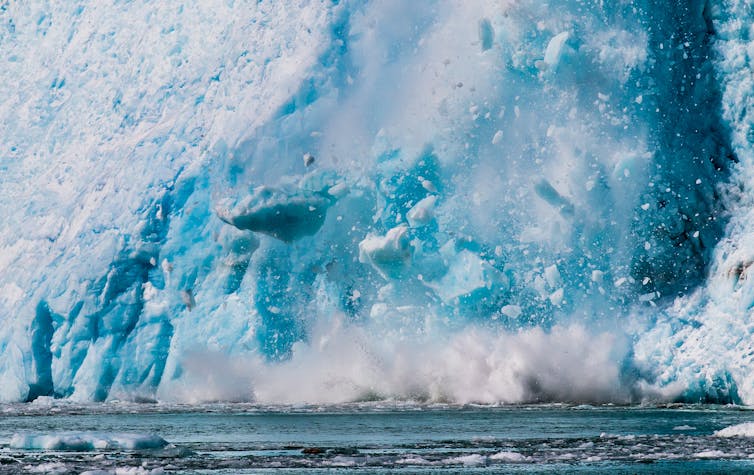Source: The Conversation – UK – By Natalie Pollard, Professor of Contemporary Literature and Culture, University of Exeter
What do you picture when you think about climate change? For many of us, it is the same set of dramatic images: melting glaciers, sinking landforms, rising seas or extreme weather.
These are powerful visuals. They shock, grab headlines and galvanise environmentalism. However, this imagery offers a partial account of transformation, often underplaying political responsibility and colonial history. In my new book, 21st-Century Climate Imaginaries, I call these charismatic images “climate memes”.
Monumental images of melting or calving glaciers lend drama to earth’s changing form, but tend to bypass the thorny social and economic roots of ice loss. Research shows that glacial melt is accelerating especially in regions at the frontline of resource extraction and colonial occupation. My research asks: why is this?

Troutnut/Shutterstock
Imagine a glacier melting in the Andes. Blood-red threads of wool – like streams of meltwater – are running down the mountain. It is 2006. This is an activist intervention by Chilean-born artist Cecilia Vicuña. It is the first in her series of performances and soft sculptures, The Blood of the Glaciers. Her giant-order red threads spell out the effects of foreign direct investment in the wake of Augusto Pinochet’s regime, which sparked a dramatic rise in overseas mining corporations in Chile.
Here, as in many regions of the developing world, mining and industrial transportation make the glaciers bleed. The problem is acute because glaciers are water savings banks, essential in years with low rainfall. Glaciers sustain life. Industry-heavy sacrifice zones bleed life dry. Vicuña’s artistic activism shows how extractive mining is a primary driver of glacial recession. Melting is not just a “climate” issue or “natural” disaster. The cause is human activity.
Standing knee-deep in seawater on the shoreline of Tuvalu, the country’s foreign minister addresses Cop26 delegates with these words: “We are sinking”. Simon Kofe’s 2021 speech was broadcast globally from a point that had recently been above sea level. From his semi-submerged podium, Kofe made visible to the world the situation people endure in low-lying Pacific islands.
Since the 1980s, sinking islands have become a powerful shorthand for climate crisis. Apocalyptic spectacles of raging seas symbolise planetary transformation. An often-cited example is the documentary of Al Gore’s An Inconvenient Truth. It showed Tuvalu engulfed by tides, alongside the incorrect remark that “Pacific nations have all had to evacuate”.
In 2009, Marshallese activist Kathy Jetñil-Kijiner joined forces with Greenlandic climate poet Aka Niviâna and environmentalist organisation 350.org. They produced an influential video-poem: Rise: From One Island to Another. The performance connects changing Greenlandic ice and Pacific waters with Indigenous resistance to fossil capitalism.
Climate images of melting and sinking often go hand-in-hand with colonial narratives of Indigenous vulnerability. In contrast, Rise brings to life the history of Greenlandic and Marshallese opposition to development for extraction and scientific exploitation. The two activists highlight the nuclear colonial legacy of the Pacific Proving Grounds and Greenland’s Camp Century, linking military histories in the Arctic and Pacific: “nuclear waste / dumped / in our waters / on our ice”.
It is not always easy to remember that environmental change is caused by specific technological, military and political acts. Indigenous arts activism helps by showing how climate memes make sense only in the context of histories of exploitation and resistance, which often take place in developing countries.
Today, activists and artists across the world are challenging popular, generalised climate memes, such as those of melting and sinking. As I show in 21st-Century Climate Imaginaries, attention to the local and specific helps people process how social and environmental violence are intimately linked. Arts activism, working directly with people’s lived experiences of change, can offer much-needed, grounded alternatives to spectacular climate soundbites. How far these interventions are positively reshaping how we understand our responsibilities to a fast-changing world is yet to be seen.
Don’t have time to read about climate change as much as you’d like?
Get a weekly roundup in your inbox instead. Every Wednesday, The Conversation’s environment editor writes Imagine, a short email that goes a little deeper into just one climate issue. Join the 45,000+ readers who’ve subscribed so far.
![]()
Natalie Pollard does not work for, consult, own shares in or receive funding from any company or organisation that would benefit from this article, and has disclosed no relevant affiliations beyond their academic appointment.
– ref. Apocalyptic images of melting glaciers and sinking islands won’t help anyone imagine a better future – https://theconversation.com/apocalyptic-images-of-melting-glaciers-and-sinking-islands-wont-help-anyone-imagine-a-better-future-268909
